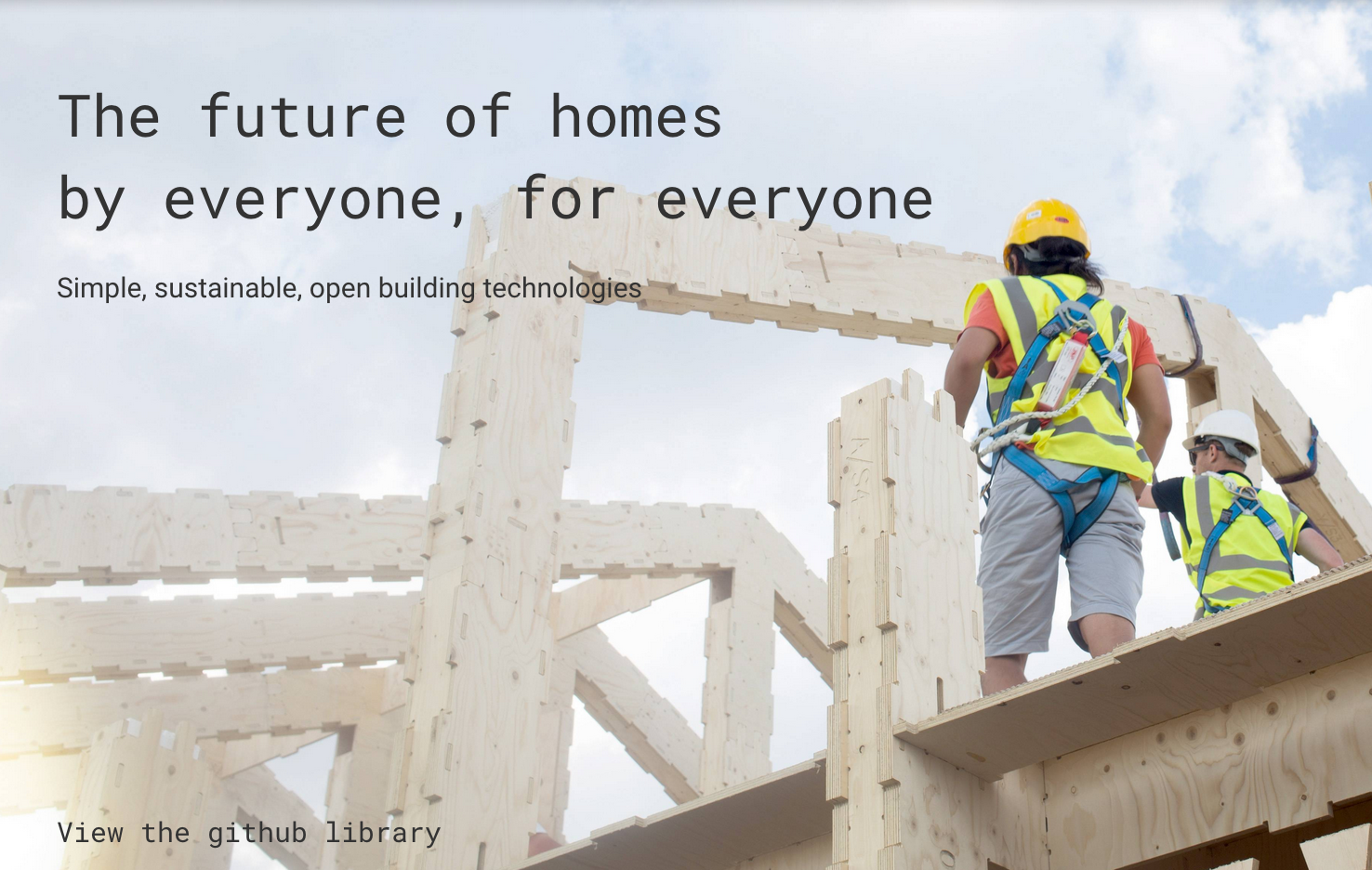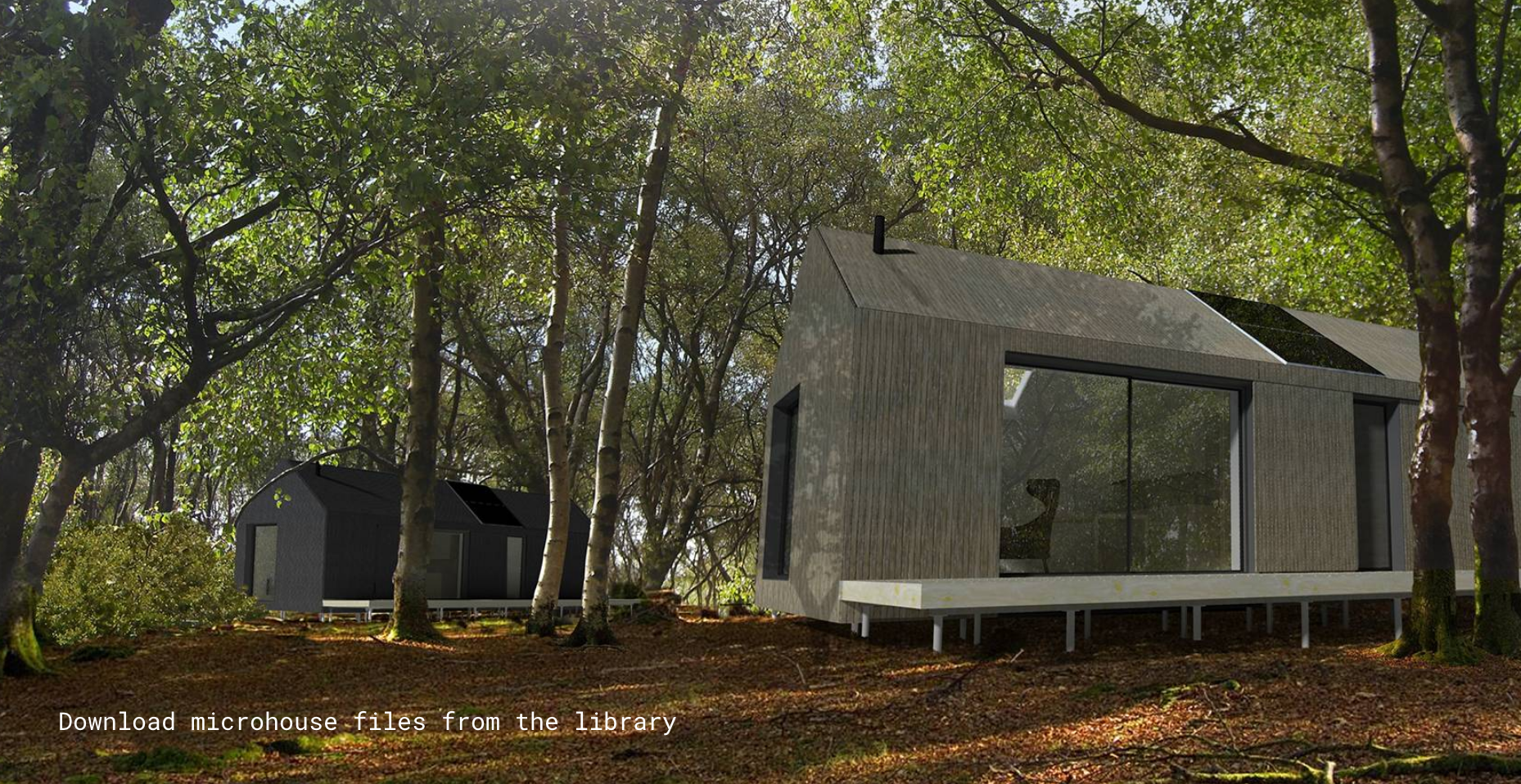Wikihouse is "an open source project to reinvent the way we make homes." At the heart of this astonishing open source construction kit is a simple question: What if, instead of architects creating buildings for those who can afford to commission them, common people could design and build their own houses?

Wikihouse construction.
source ![]()
Wikihouse's methodology seeks to build housing that is simpler, more affordable, ecologically sustainable, and easy for anyone to use and improve upon:
... a big IKEA kit for your home that is easy to assemble and affordable.
The Wikihouse Design Principles set forth fifteen guidelines that architects, designers, engineers, investors, manufacturers and builders are using to achieve this transformation.
# Aspirational Goals
Wikihouse as institutional structure facilitates collaborations among companies, organizations and governments to
develop new open technologies, standards and common infrastructures for housing and sustainable development.
The project wants to put the design solutions for building low-cost, low-energy, high-performance homes
into the hands of every citizen and business on earth.And they want to
grow a new, distributed housing industry, comprising many citizens, communities and small businesses developing homes and neighborhoods for themselves, reducing our dependence on top-down, debt-heavy mass housing systems.
xxxxx
# Legal status and Location
The Wikihouse Foundation (html ![]() ) is a nonprofit open technology foundation (??) based in Great Britain, Europe, transnational
) is a nonprofit open technology foundation (??) based in Great Britain, Europe, transnational
# How it started
In 2011, two recent architectural graduates, Alastair Parvin and Nicholas Ierodiaconou, joined a London design practice called Zero Zero Architecture, where they were able to experiment with their ideas about open design (wiki ![]() ).
).
Parvin and Ierodiaconou found that a familiar technology known as CNC – computer numerical control fabrication – would allow them to make digital designs that could be used to fabricate large, flat housing components from plywood. This eventually led them to publish open source files for houses. The idea was to allow anyone to modify and improve the designs for different circumstances, and to enable unskilled labor to quickly and inexpensively erect the structural shell of a home. They called it Wikihouse.
As recounted by Wikipedia html ![]() , Wikihouse won a TEDGlobal case prize in 2012, which spurred it to enter into a partnership to build WIkihouses in a favela in Rio de Janeiro.
, Wikihouse won a TEDGlobal case prize in 2012, which spurred it to enter into a partnership to build WIkihouses in a favela in Rio de Janeiro.
Other such partnerships were planned, along with efforts to build WikiHouses to assist in disaster relief efforts. While several prototype houses have been built in Scotland, New Zealand, Austria, Mexico (video ![]() ) and other countries, the project remains mostly in an prototype stage.
) and other countries, the project remains mostly in an prototype stage.
YOUTUBE Mlt6kaNjoeI Alastair Parvin's Ted Talk in 2012
# How do they work?
One of the core assumptions of Wikihouse is that:
Digital design allows every home to be designed as code, instantly costumized to its site and users, whilst keeping control over cost. (html)
This philosophy for the technology, economics and processes of house-building are given greater elaboration in the Wikihouse Design Principles, which we consider a beautiful example of a Commons Charter. It urges participants to “share global, manufacture local”; design to lower thresholds (to reduce the time, cost, skill and energy needed); rely on open standards and open source share-alike licenses; and empower users to repair and modify features of their homes; among other practices.
Since its beginnings, Wikihouse has blossomed into a global design community with independent chapters in several countries.
# Peer Governance in the Commons
Assemblage source ![]()
Formally, Wikihouse is "managed" by the Wikihosue Foundation. But as a creature of the open source software world and the respective social practices, it is self-organized, voluntary, collaborative community of professionals and amateurs interested in a new vision of housing design and construction.
There is certainly a kind of commons of designers, architects, engineers, researchers, students and so forth, in developing the WikiHouse organizational and building models. Among communities and users, however, that is apparently more aspirational than real at this point.
The Wikihouse founders had apparently no doubts about the necessity to develop shared purpose & values. They laid them down in the Wikihouse Design Principles.
In classic open-source style, the community shares its ideas, designs and latest innovations so that anyone can use them and build upon them. Wikihouse encourages people to freely use their ideas, they share knowledge often & widely and honor transparency in a sphere of trust. This is yet another case of developing greater value through the open sharing of an intangible resource (designs) than through proprietary ownership.

Wikihouse houses.
source ![]()
While Foundation team of seven people takes the initiative in research and development, design development, partnerships, and so forth, the project must also assure commoners' consent in decisionmaking, lest they drift away and simply ignore Wikihouse.
Ultimately, many participants in the Wikihouse commons have only a casual commitment to other participants or to the Wikihouse principles. This is consistent with many open source projects, which invite deep commitments by people but do not require them.
In effect, Wikihouse serves to relationalize property by licensing it with open licenses.
A neighborhood built by one person is a non-place.
YOUTUBE aWusENSQGbs Alastair Parvin: Housing without Debt, talk in the House of Commons in 2016
The important thing to understand is: What they (conventional designers and architects) are making here are not homes. They are making property assets to sell.
It is clear that Wikihouse seeks to share the risks of provisioning, make & use together, and use some form of commons-based mutual support in making WikiHouses available to ordinary people, while controling the cost of the whole process. Certainly they rely on distributed structures, produce cosmo-Locally, and cocreate generative change. In its very conception, Wikihouse are a larger scale will use convivial tools. It remains to be see how it would trade with price-sovereignty, if at all, or protect & extend value sovereignty.
POST http://image-transporter.apps.allmende.io/image
ontological ground and political culture
# Inner Kernel
- Relational categories. name them - Epistemology. - Ubuntu-Rationality.
White Paper by Wikihouse Founders on Housing Crisis in UK, html ![]()
- Beat the Bounds - Establish Discrimination-Free Infrastructures - Finance Commons-Public-Circuits - Accept State Mediation & Support if Needed - Emulate & Then Federate
tag
# Realms of Commoning
meta
# Sources
Wikihouse website html ![]()
Tristan Copley-Smith, "The Growth of Open Design and Production," in Patterns of Commoning (Off the Common Books, 2015), pp. 154-158. html ![]()
Wikihouse entry, Wikipedia html ![]()